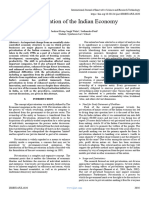Adv N Disadv of Privatisation of Health Sector in India
Adv N Disadv of Privatisation of Health Sector in India
Uploaded by
Chanthini VinayagamCopyright:
Available Formats
Adv N Disadv of Privatisation of Health Sector in India
Adv N Disadv of Privatisation of Health Sector in India
Uploaded by
Chanthini VinayagamOriginal Title
Copyright
Available Formats
Share this document
Did you find this document useful?
Is this content inappropriate?
Copyright:
Available Formats
Adv N Disadv of Privatisation of Health Sector in India
Adv N Disadv of Privatisation of Health Sector in India
Uploaded by
Chanthini VinayagamCopyright:
Available Formats
International Journal of Advanced System and Social Engineering Research ISSN 2278-6031, Vol 3, Issue 1, 2013, pp18-22 http://www.bipublication.
com
ADVANTAGES AND DISADVANTAGES OF PRIVATISATION IN INDIA
Anant Kousadikar and Trivender Kumar Singh*
*Jatan Swaroop PostGraduate College, Kayasthwada,Sikandrabad(U.P.), Distt: Bulandshar [Received-05/12/2012, Published-17/01/2013]
ABSTRACT
Privatization in generic terms refers to the process of transfer of ownership, can be of both permanent or long term lease in nature, of a once upon a time state-owned or public owned property to individuals or groups that intend to utilize it for private benefits and run the entity with the aim of profit maximization. In other words, it is a route from public or state ownership to private players or a group. From the other point of view, it is a strategy that provides advantages to a few at the price of many. However, this is always subjected to the circumstances involved. In this paper, the aim is to understand the major advantages and disadvantages of privatization in this country. Index Terms: Privatisation, advantages, Public administration.
I. INTRODUCTION Privatization is a managerial approach that has attracted the interest of many categories of peopleacademicians, politicians, government employees, players of the private sector, and public on the whole. As per the opinion by the subject experts, privatization can be advantageous in terms of the higher flexibility and scope of innovation it offers along with cost savings, many a times. However, other specialists defiantly debate that privatization has an adverse impact on the employee morale and generate fear of dislocation or termination. More likely it also adds on to the apprehensions pertaining to accountability and quality. Experts both advocate and criticize privatization making it more or less a provocative decision that calls for a diligent scrutiny by the decision makers in assessment of pros and cons attached to the concerned policy [20]. In India, privatization has been accepted with a lot of resistance and has been dormant initially during the inception period of economic liberalization in the country [8]. The article intends to analyze the present status of privatization in India and summarize its advantages and disadvantages in context with the Indian Economy. II. PRIMARY FEATURES OF PRIVATIZATION Espousing market principles by public policy makers has evolved as one of the prominent characteristics of the contemporary public enterprise management which encompasses privatization as a primary facet. Privatization of State- owned enterprises has developed as a critical tool for economic policies pertaining to progress and development of developing countries. One of the prominent feature of privatization is the enhanced competitive characteristics it provides to the enterprises which prove to be fruitful for the
ADVANTAGES AND DISADVANTAGES OF PRIVATISATION IN INDIA
business as well as the country. However, privatization contracts are greatly influenced by merger variables and even global issues and are structured on the basis of manipulation of the government and the private players along with the administering jurisdiction [19]. Perotti and Guney (1993) cited in Al-Zuhair[2], have supported privatization as a vital source to enhance economic enticements, magnetize better managerial skills of the private sector, extend the share ownership, lower the public borrowings in order to sustain sustainable services. Shirley (1988) cited in AlZuhair [2], view privatization as an attempt to enhance market potencies. Privatization is an essentially effective tool for restructuring and reforming the public sector enterprises running without significant aim and mission as private sector is perceived to be fundamentally more selfmotivated, prolific and reliable for superior quality of products and services. Privatization can be of three prominent types: Delegation: Government keeps hold of responsibility and private enterprise handles fully or partly the delivery of product and services. Divestment: Government surrenders the responsibility. Displacement: The private enterprise expands and gradually displaces the government entity [15]. III. PRIVATIZATION IN INDIA: AN OVERVIEW Privatization in India is still at a minimalist level. Privatization by way of sale of public sector enterprises is almost negligible while divestment is also existent by way of selling of a portion of shares of the 31 public sector enterprises. Privatization got tremendous boost by the introduction of new economic policy in 1991 that allowed delicensing, relaxing entry restrictions and equity funding [4]. This heightened the competition in the industries that were monopolized by the public sector earlier. State owned enterprises were lacking the finesse that private enterprises
employed as the competitive edge. Deregulation in India was facilitated by laws like the Industries (Development & Regulation) Act, 1951 (IDRA), Monopolies & Restrictive Trade Practices Act, 1969, (MRTPA), Foreign Exchange regulation Act, 1973 (FERA), Capital Issues Control and technical scrutiny by the Directorate General of Technical Development (DGTD) (Goyal, n.d.). Postindependence, the Indian government adopted socialistic economic strategies. It was in 1980s, that Rajiv Gandhi initiated economic restructuring. With the help of IMF, Indian government commenced a sequential economic reorganization. P.V. Narasimha Rao brought in the revolutionary economic developments with the help of Dr. Manmohan Singh. The results of these reforms can be assessed statistically by comparing the total overseas investment in terms of portfolio investment, FDI and investments from foreign equity capital markets. In 1995-1996, it was $5.3 billion as compared to $ 132 million in 1991-1992. The highlights of the reforms including eradicating license raj for all except 18 critical sectors for licensing; tempering the control on industries; Foreign Technology Agreements; FDI & FII; amendment of MRTP Act, 1969; Deregulation; Regulation of Inflation; Tax restructuring; encouraging overseas business relations [11]. Few examples of privatization in India are Lagan Jute Machinery Company Limited, Modern Food Industries Limited, BALCO, Hotel Corporation of India Limited, Hindustan Zinc Limited, Paradeep Phosphates Limited, BSNL etc. IV. GOVERNMENT OPPOSITION TO COMPLETE PRIVATIZATION In the 1990s, the budgeting process adopted by Indian government, fiscal deficits, and negative balance of payments boosted the governments desire and necessity to extract and release the massive investments made in the state owned enterprises and this led to privatization in India. This paved way for Foreign Direct Investments and liberalization of business practices and protocols as
Anant Kousadikar and Trivender Kumar Singh
19
ADVANTAGES AND DISADVANTAGES OF PRIVATISATION IN INDIA
well [10]. However, being a socialistic economy, the government has not ever favored complete privatization for the very basic reason that private players shall enter into the strategically important industries and shall use them for their own benefits and profit maximization [13]. Experts are of the view that Indian government wrongly positioned their disinvestment strategy by dangling between the principles and accommodating approaches. Though all political parties acknowledged the doctrine of privatization but all adopted an escapist attitude towards complete privatization for safe guarding their vote banks. They employed tactics of videshi and swadeshi, and strategies like getting a strategic partner or enlarge the equity base through and initial public offer before divesting [10]. Indian government has been conservative in allowing partial privatization of strategic sectors like power supply, telecom, banking, roadways, insurance, civil aviation, postage and telegraph services etc. Mostly, both state owned enterprises and privately run enterprises co-exist in these sectors. Government uses the shield of social interests of the employees of the PSUs to camouflage the interest of the bureaucrats and politicians. However, intensified competition of the delicensed and liberalized sectors have surely made the lethargic state owned enterprises to pull up their socks and shedding the complacency of monopoly to face the competition [14]. V. ADVANTAGES OF PRIVATIZATION Privatization indeed is beneficial for the growth and sustainability of the state-owned enterprises. The advantages of privatization can be perceived from both microeconomic and macroeconomic impacts that privatization exerts. A. Microeconomic advantages: State owned enterprises usually are outdone by the private enterprises competitively. When compared the latter show better results in terms of revenues and efficiency and productivity. Hence,
privatization can provide the necessary impetus to the underperforming PSUs [16]. Privatization brings about radical structural changes providing momentum in the competitive sectors [16]. Privatization leads to adoption of the global best practices along with management and motivation of the best human talent to foster sustainable competitive advantage and improvised management of resources. B. Macroeconomic advantages: Privatization has a positive impact on the financial health of the sector which was previously state dominated by way of reducing the deficits and debts [6,3]. The net transfer to the State owned Enterprises is lowered through privatization [6,3]. Helps in escalating the performance benchmarks of the industry in general [6,3]. Can initially have an undesirable impact on the employees but gradually in the long term, shall prove beneficial for the growth and prosperity of the employees [6,3]. Privatized enterprises provide better and prompt services to the customers and help in improving the overall infrastructure of the country. VI. DISADVANTAGES OF PRIVATIZATION Privatization in spite of the numerous benefits it provides to the state owned enterprises, there is the other side to it as well. Here are the prominent disadvantages of privatization: Private sector focuses more on profit maximization and less on social objectives unlike public sector that initiates socially viable adjustments in case of emergencies and criticalities [9,1]. There is lack of transparency in private sector and stakeholders do not get the complete information about the functionality of the enterprise [9,1]. Privatization has provided the unnecessary support to the corruption and illegitimate ways of accomplishments of licenses and business deals
Anant Kousadikar and Trivender Kumar Singh
20
ADVANTAGES AND DISADVANTAGES OF PRIVATISATION IN INDIA
amongst the government and private bidders. Lobbying and bribery are the common issues tarnishing the practical applicability of privatization [1]. Privatization loses the mission with which the enterprise was established and profit maximization agenda encourages malpractices like production of lower quality products, elevating the hidden indirect costs, price escalation etc. [9]. Privatization results in high employee turnover and a lot of investment is required to train the lesser-qualified staff and even making the existing manpower of PSU abreast with the latest business practices [9]. There can be a conflict of interest amongst stakeholders and the management of the buyer private company and initial resistance to change can hamper the performance of the enterprise [1]. Privatization escalates price inflation in general as privatized enterprises do not enjoy government subsidies after the deal and the burden of this inflation affects the common man. VII. FUTURE PROSPECTS FOR INDIA Indian economy is a dynamic economy that is showing tremendous potential of growth. Globalization, liberalization and privatization are the key strategic mandates for economic policies. Market oriented reforms are sustainable and are gaining acceptance with resistance to privatization going down due to the benefits like enhanced efficiency through target oriented management and disposition of public funds into social and physical infrastructure of the country. Privatization has shown great outcomes in the development of sectors like banking, insurance, telecom, power, civil aviation etc. However, the lobbying in domestic circuits was enfeebled by the surprising reversal of the Indian economy in present time. Indian economy registered an average growth of 8.5 per cent in the past four years and it is evidence enough to highlight the potential of privatization and its need and likelihoods of privatization [12]. However, it is disheartening to acknowledge that
India is not a very alluring destination for foreign investors. Bureaucracy, red tapism, political hiccups, corruption are also prominent hindrances in the development of India that offers ample of skilled and cheap labor and inadequate capital. In spite of all the hurdles, it is a viable to expect higher rate of returns as compared to capital intensive industrialized countries. With more liberal reforms in the making, future of privatization seems to be bright and a salubrious flow of foreign investment and even development of domestic private players to take charge of the struggling PSUs and turn them around [17]. VIII. CONCLUSION Over the time, Indian policy makers have shed their inhibitions about privatization and have formulated liberal reforms to divest the huge capital investment in PSUs and enhance the efficiency and profit generation of the state owned enterprises. Many sectors wherein entry barriers were too high were loosened up to welcome investments from both domestic as well as international investors. Sectors that showed tremendous success after privatization are insurance, banking, civil aviation, telecom, power etc. However, complete privatization is still a far-fetched dream. In most of the liberalized sectors, government control is still evident and there is more of delegation or joint ventures between public and private sector are functional like Maruti Suzuki etc. REFERENCES
1. Ahmad, F., 2011. Privatization : A View at Developing Countries, Degree Thesis, International Business, Arcada 2. Al-Zuhair, M., 2008. Privatization Programs, Ownership Structures and Market Development: The Role of Country Characteristics on Defining Corporate Governance Standards, Ann Arbor: ProQuest 3. Filipovic, A., 2005. Impact of Privatization on Economic Growth, Issues in Political Economy, 14, Pp. 1-22 4. Gouri, G., 1996. Privatization and Public Sector Enterprises in India: Analysis of Impact of a Non-
Anant Kousadikar and Trivender Kumar Singh
21
ADVANTAGES AND DISADVANTAGES OF PRIVATISATION IN INDIA
Policy, Economic and Political Weekly, 31(48), Pp. 63-74 5. Goyal, S., n.d. Privatization in India, [pdf], Available at: http://www.ilo.org/public/english/region/asro/bangk ok/paper/privatize/chap3-1.pdf [Accessed 27 December 2012] 6. Guriev, S. and Megginson, W., 2005. Privatization: What have we learnt?, ABCDE Conference, St. Petersburg, January, 2005. 7. Jain, R., Raghuram, G. and Gangwar, R., 2007. Airport Privatization in India: Lessons from the bidding Process in Delhi and Mumbai, Working Paper No. 2007- 05-01, Research and Publications, Indian Institute of Management, Ahmedabad. 8. Kapur, D. and Ramamurti, R., 2002. Privatization in India: The Imperatives and Consequences of Gradualism, White Paper, Conference on Policy Reform in India, Stanford University, June3-4, 2002, Pp. 1- 40 9. Lokyo, S., 2012. Privatization Study, LWVSJC, February 18, 2012. 10. Malik, V., 2003. Disinvestments in India: Needed Change in Mindset, Interfaces, Vikalpa, 28(3), Pp. 57-63. 11. Maps of India, 2010. Liberalisation, Privatization and Globalisation in India, [online], Available at: http://business.mapsofindia.com/indiapolicy/liberalization-privatization-globalization.html [Accessed 27 December 2012] 12. Mohan, T., 2007. Privatization and FDI: The Indian Experience, Working Paper 2007-20, Indian Institute of Management, Ahmedabad. 13. Ohri, M., n.d. Airport Privatization in India- A Study of Different Modes of Infrastructure Provision, Paper, University of Delhi, Faculty of Management Studies 14. Raghunathan, V., 2006. Leave Behind the Monopoly Mindset, Times of India, February 17, 2006. 15. Savas, E., 2006. Privatization and Public- Private Partnerships, [pdf] Available at: http://www.cesmadrid.es/documentos/sem200601_m d02_in.pdf [Accessed 27 December 2012] 16. Sheshinski, E. and Lopez-Calva, L., 2003. Privatization and Its Benefits: Theory and Evidence, CESifo Economic Studies, 49(3), Pp. 429-459
17. Srinivasan, T., 2003. Indian Economy: Current Problems and Future Prospects, ICFAI Journal of Applied Economics, 2003, Pp.1- 24 18. Star, P., 1988. The Meaning of Privatization, Yale Law & Policy Review, 6(1), Pp.6-41. 19. Ullman, A. and Lewis, A., 1997. Privatization and Entrepreneurship: The Managerial Challenge in Central and Eastern Europe, New York: Haworth 20. Young, R., 2005. On Privatization- Competitive Sourcing in State Government, IPSPR E Journal, May 2005: Institute of Public Service and Policy Research, University of South Carolina.
Anant Kousadikar and Trivender Kumar Singh
22
You might also like
- State Owned Enterprises Performance and Compliance Survey ReportDocument52 pagesState Owned Enterprises Performance and Compliance Survey ReportMirandahNo ratings yet
- Public Corporations: General PrinciplesDocument23 pagesPublic Corporations: General PrinciplesMonefah Mulok100% (2)
- LPG Policy of India and Its EffectsDocument15 pagesLPG Policy of India and Its EffectsAsif100% (1)
- Need For The Slow Pace of PrivatizationDocument5 pagesNeed For The Slow Pace of PrivatizationSanchit Garg0% (3)
- Common Prefixes and SuffixesDocument2 pagesCommon Prefixes and SuffixesChanthini Vinayagam100% (1)
- Bates Gill and James Reilly. 2007. The Tenuous Hold of China Inc. in Africa. The Washington Quarterly (Summer 2007) Volume 30 Number 3 Pp. 37-52Document16 pagesBates Gill and James Reilly. 2007. The Tenuous Hold of China Inc. in Africa. The Washington Quarterly (Summer 2007) Volume 30 Number 3 Pp. 37-52Wu GuifengNo ratings yet
- Advantages and Disadvantages of Privatisation in IndiaDocument5 pagesAdvantages and Disadvantages of Privatisation in Indianikita mukeshNo ratings yet
- Advantages and Disadvantages of Privatisation in IndiaDocument1 pageAdvantages and Disadvantages of Privatisation in IndiaZuraida RamzanNo ratings yet
- Divestment and PrivatisationDocument16 pagesDivestment and Privatisationlali62No ratings yet
- LPG Policy of India and Its EffectsDocument18 pagesLPG Policy of India and Its EffectsFACTS YOU MISSED -हिंदीNo ratings yet
- Disinvestment Synopsis ImpDocument10 pagesDisinvestment Synopsis ImpSarita GautamNo ratings yet
- Vision IAS Mains Test 5 2021Document22 pagesVision IAS Mains Test 5 2021Amar GoswamiNo ratings yet
- Privatisation and DisinvestmentDocument10 pagesPrivatisation and DisinvestmentSachin MangutkarNo ratings yet
- Stages of InternationalizationDocument28 pagesStages of InternationalizationIshita KheriaNo ratings yet
- Ravi Bang's Eco Final DraftDocument30 pagesRavi Bang's Eco Final DraftRavi BangNo ratings yet
- Disinvestment in IndiaDocument32 pagesDisinvestment in IndiaDixita ParmarNo ratings yet
- National Law Institute UniversityDocument18 pagesNational Law Institute UniversityHrishika NetamNo ratings yet
- PrivatisationDocument19 pagesPrivatisationNishil MehraNo ratings yet
- RSTV The Big Picture Privatisation of Public Sector EnterprisesDocument4 pagesRSTV The Big Picture Privatisation of Public Sector EnterprisesAbhishekNo ratings yet
- Disinvestment An OverviewDocument8 pagesDisinvestment An OverviewRavindra GoyalNo ratings yet
- Privatization Can Be of Three Prominent TypesDocument2 pagesPrivatization Can Be of Three Prominent TypesLeslin BruttusNo ratings yet
- Privatization and Disinvestment: BY: Apala Gupta Garima Soni Minakshi Sinha Shraddha ChapekarDocument39 pagesPrivatization and Disinvestment: BY: Apala Gupta Garima Soni Minakshi Sinha Shraddha ChapekarvinodkumardasNo ratings yet
- Privatization of GOVERNMENT ASSETS: Good or BadDocument21 pagesPrivatization of GOVERNMENT ASSETS: Good or BadProf. R V SinghNo ratings yet
- Competition LawDocument18 pagesCompetition Lawmuhammed farzinNo ratings yet
- IBE PrivatisationDocument15 pagesIBE Privatisationaleenam.shaheerNo ratings yet
- Privatization of Public Assets - Rough-1Document5 pagesPrivatization of Public Assets - Rough-121BEC153Subiksha MerinNo ratings yet
- Business Env.. PrivatizationDocument8 pagesBusiness Env.. Privatizationklair_deepika5602No ratings yet
- Privatization & Disinvestment'sDocument13 pagesPrivatization & Disinvestment'sarifshaikh99No ratings yet
- Ijarm: International Journal of Advanced Research in Management (Ijarm)Document13 pagesIjarm: International Journal of Advanced Research in Management (Ijarm)IAEME PublicationNo ratings yet
- IJCRT2004624Document8 pagesIJCRT2004624mrdarshin48No ratings yet
- Disinvestment and PrivatisationDocument40 pagesDisinvestment and Privatisationpiyush909No ratings yet
- Disinvestment and PrivatisationDocument30 pagesDisinvestment and PrivatisationSantosh MashalNo ratings yet
- 6398-Article Text-10418-2-10-20171207 PDFDocument8 pages6398-Article Text-10418-2-10-20171207 PDFSajeel AhmedNo ratings yet
- Disinvestment of 23 Psus: Rstv-Big PictureDocument3 pagesDisinvestment of 23 Psus: Rstv-Big PictureAbhishekNo ratings yet
- C 10 Hindustan Petroleum Company LimitedDocument4 pagesC 10 Hindustan Petroleum Company LimitedNakshtra DasNo ratings yet
- Disinvestment Policy in India: Progress and Challenges: ManagementDocument3 pagesDisinvestment Policy in India: Progress and Challenges: ManagementK MNo ratings yet
- TLP Phase 1 - Day 13 Synopsis: Challenges of PSU's in India TodayDocument10 pagesTLP Phase 1 - Day 13 Synopsis: Challenges of PSU's in India TodayShivran RoyNo ratings yet
- Chapter - 5 Analysis of Problems and Prospects of DisinvestmentDocument15 pagesChapter - 5 Analysis of Problems and Prospects of Disinvestmentmohd sheerafNo ratings yet
- PrivatizationDocument11 pagesPrivatizationKrisha Mae CaguranganNo ratings yet
- 6.18, DR Nayan DeepDocument10 pages6.18, DR Nayan Deepramzan.khadim89No ratings yet
- Lect Topic 3.1 PrivatizationDocument22 pagesLect Topic 3.1 PrivatizationKertik SinghNo ratings yet
- Paper-II (Part-2)Document3 pagesPaper-II (Part-2)focusahead.broNo ratings yet
- Finanacial Adm (CA)Document2 pagesFinanacial Adm (CA)aleenam.shaheerNo ratings yet
- Causes of PrivatisationDocument9 pagesCauses of PrivatisationNipunNo ratings yet
- The New Industrial POLICY-1991Document26 pagesThe New Industrial POLICY-1991bbhoeeNo ratings yet
- Disinvestment Policy in India: Progress and Challenges: Assistant Professor, S.A. Jain College, Ambala CityDocument12 pagesDisinvestment Policy in India: Progress and Challenges: Assistant Professor, S.A. Jain College, Ambala CitySid SharmaNo ratings yet
- Economic Issue - Concentration of Economic PowerDocument8 pagesEconomic Issue - Concentration of Economic PowerAmandeep KaurNo ratings yet
- Objective of DisinvestmentDocument9 pagesObjective of Disinvestmentsaketms009No ratings yet
- Disinvestment in India 2Document111 pagesDisinvestment in India 2Kunjan GandhiNo ratings yet
- Dis InvestmentDocument16 pagesDis Investmentsree.funyanNo ratings yet
- DISINVESTMENTDocument6 pagesDISINVESTMENTR SURESH KUMAR IINo ratings yet
- Disinvestment in Public SectorDocument7 pagesDisinvestment in Public SectorRajs MalikNo ratings yet
- Chapter 3 - Global Trading EnvironmentDocument46 pagesChapter 3 - Global Trading Environmentkirthi nairNo ratings yet
- Mco 04Document27 pagesMco 04meenakshivnair001No ratings yet
- Rishikesh Raj Singh (Muthoot Group)Document58 pagesRishikesh Raj Singh (Muthoot Group)Rishikesh Raj SinghNo ratings yet
- Chapter - 23Document14 pagesChapter - 23rjvmafiaNo ratings yet
- Privatisation of The Indian EconomyDocument5 pagesPrivatisation of The Indian EconomyInternational Journal of Innovative Science and Research TechnologyNo ratings yet
- LPG Reforms in India 1Document7 pagesLPG Reforms in India 1itsvanshikaushalyaNo ratings yet
- Corporate GrowthDocument5 pagesCorporate Growthblind_readerNo ratings yet
- Econ ProjectDocument2 pagesEcon ProjectShahaan QureshiNo ratings yet
- Importance of Business EnvironmentDocument8 pagesImportance of Business EnvironmentRiskyeiNo ratings yet
- Public Private Partnership-: Lessons from Gujarat for Uttar PradeshFrom EverandPublic Private Partnership-: Lessons from Gujarat for Uttar PradeshNo ratings yet
- The Maruti Story: How A Public Sector Company Put India On WheelsFrom EverandThe Maruti Story: How A Public Sector Company Put India On WheelsRating: 3 out of 5 stars3/5 (1)
- 30 Days Push Up ChallengeDocument3 pages30 Days Push Up ChallengeChanthini VinayagamNo ratings yet
- GM DietDocument8 pagesGM DietChanthini Vinayagam100% (1)
- StorytellingDocument5 pagesStorytellingChanthini VinayagamNo ratings yet
- A Survey of TQM Application in Healthcare - Case Analysis: Chanthini.VDocument15 pagesA Survey of TQM Application in Healthcare - Case Analysis: Chanthini.VChanthini VinayagamNo ratings yet
- Cardinal Utility ApproachDocument5 pagesCardinal Utility ApproachChanthini Vinayagam100% (3)
- BCG Growth-Share Matrix: Invest in and Which Ones Should Be DivestedDocument5 pagesBCG Growth-Share Matrix: Invest in and Which Ones Should Be DivestedChanthini VinayagamNo ratings yet
- Mohr V WilliamDocument5 pagesMohr V WilliamChanthini VinayagamNo ratings yet
- Sterilization Methods and PrinciplesDocument11 pagesSterilization Methods and PrinciplesChanthini VinayagamNo ratings yet
- Perception Online NotesDocument13 pagesPerception Online NotesChanthini VinayagamNo ratings yet
- MBE NotesDocument154 pagesMBE NotesSimson SimNo ratings yet
- Concept and Principles of HomeopathyDocument2 pagesConcept and Principles of HomeopathyChanthini Vinayagam100% (1)
- Abc in CPRDocument3 pagesAbc in CPRChanthini VinayagamNo ratings yet
- Revised Sterilization Methods and Principles PDFDocument21 pagesRevised Sterilization Methods and Principles PDFSiva Raman100% (1)
- First Aid - CPR - AED Adult Ready ReferenceDocument12 pagesFirst Aid - CPR - AED Adult Ready Referenceadamiam100% (1)
- Change Management Leadership GuideDocument30 pagesChange Management Leadership GuideChanthini Vinayagam100% (2)
- Simulink TutDocument19 pagesSimulink TutChanthini VinayagamNo ratings yet
- Microprocessor 80386Document5 pagesMicroprocessor 80386Chanthini VinayagamNo ratings yet
- Ss 2 First Term Commerce ExaminationDocument6 pagesSs 2 First Term Commerce ExaminationUzoma Obasi100% (1)
- Brandsen 2010 Contextualizing - The - Meaning - of - Public - MaDocument20 pagesBrandsen 2010 Contextualizing - The - Meaning - of - Public - MaLeon LerborgNo ratings yet
- The List of Public Sector Undertakings in India Details All inDocument26 pagesThe List of Public Sector Undertakings in India Details All inJoydeep SenguptaNo ratings yet
- Public Service Vacancy Circular - Publication No 24 of 2024 - Date Issued 05 July 2024Document67 pagesPublic Service Vacancy Circular - Publication No 24 of 2024 - Date Issued 05 July 2024sibongilesithole983No ratings yet
- Public Sector UndertakingsDocument13 pagesPublic Sector Undertakingslali62No ratings yet
- Nicholas Borst CLM Issue 75Document21 pagesNicholas Borst CLM Issue 75Ghanashyam MuthukumarNo ratings yet
- Law Number 11/1967 On The Basic Provisions of MiningDocument30 pagesLaw Number 11/1967 On The Basic Provisions of MiningDidik Hari PambudiNo ratings yet
- Indonesia - Gulf News Part IIDocument20 pagesIndonesia - Gulf News Part IIdaerahkoranNo ratings yet
- 121 - Porter Diamond & CAGE - TurkmenistanDocument17 pages121 - Porter Diamond & CAGE - TurkmenistanMRASSASINNo ratings yet
- New PublicDocument25 pagesNew PublicImrangillNo ratings yet
- Industrial Policy - 1991Document30 pagesIndustrial Policy - 1991lulughoshNo ratings yet
- Trends in Public & Private Sector in India.: BY: Ashutosh Gupta Krishan KumarDocument29 pagesTrends in Public & Private Sector in India.: BY: Ashutosh Gupta Krishan KumarAkashdeep GhummanNo ratings yet
- Business Studies End Semester NotesDocument45 pagesBusiness Studies End Semester Notesrbkia332No ratings yet
- Super Mandiwanzira Corruption Letter To President EDDocument12 pagesSuper Mandiwanzira Corruption Letter To President EDIcho ChariraNo ratings yet
- Public SectorDocument13 pagesPublic SectorPradnya SurwadeNo ratings yet
- Scales of BusinessDocument23 pagesScales of BusinessShrikant RathodNo ratings yet
- State Controls, Markets and Washington ConsensusDocument27 pagesState Controls, Markets and Washington ConsensusdevilzclubNo ratings yet
- Isi & EoiDocument26 pagesIsi & EoiTaghreed Badr Al-deenNo ratings yet
- Assignment of Corporate GovernanceDocument8 pagesAssignment of Corporate GovernanceOnek KothaNo ratings yet
- Current Philosophy of Government Business in NigeriaDocument10 pagesCurrent Philosophy of Government Business in Nigeriaxaxif8265No ratings yet
- Maharashtra National Law University, Aurangabad: EconomicsDocument19 pagesMaharashtra National Law University, Aurangabad: EconomicsSipun SahooNo ratings yet
- Stabilization Adjustment Reform and PrivatizationDocument30 pagesStabilization Adjustment Reform and PrivatizationDannis Anne RegajalNo ratings yet
- Publikasi Ilmiah PDFDocument23 pagesPublikasi Ilmiah PDFYehezkiel SinggihNo ratings yet
- Industrial PolicyDocument16 pagesIndustrial PolicySudhir Kumar YadavNo ratings yet
- Role of Public SectorDocument4 pagesRole of Public SectorSuryansh GargNo ratings yet
- The Roles of Private Companies in The Development of Nigeria EconomyDocument41 pagesThe Roles of Private Companies in The Development of Nigeria Economytemitopeabdulgafar8100% (1)
- Part 6 Vol 2 - Judicial Commission of Inquiry Into State Capture ReportDocument503 pagesPart 6 Vol 2 - Judicial Commission of Inquiry Into State Capture ReportMbatha PhumzileNo ratings yet











































































































